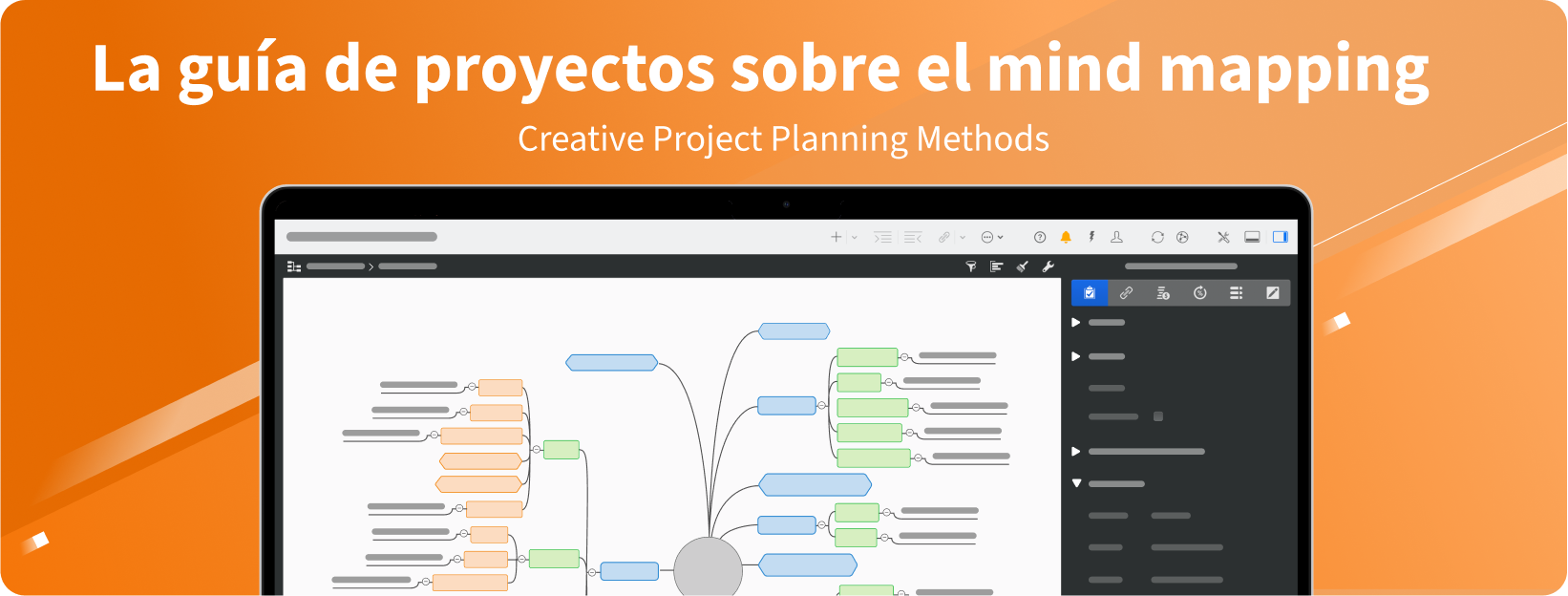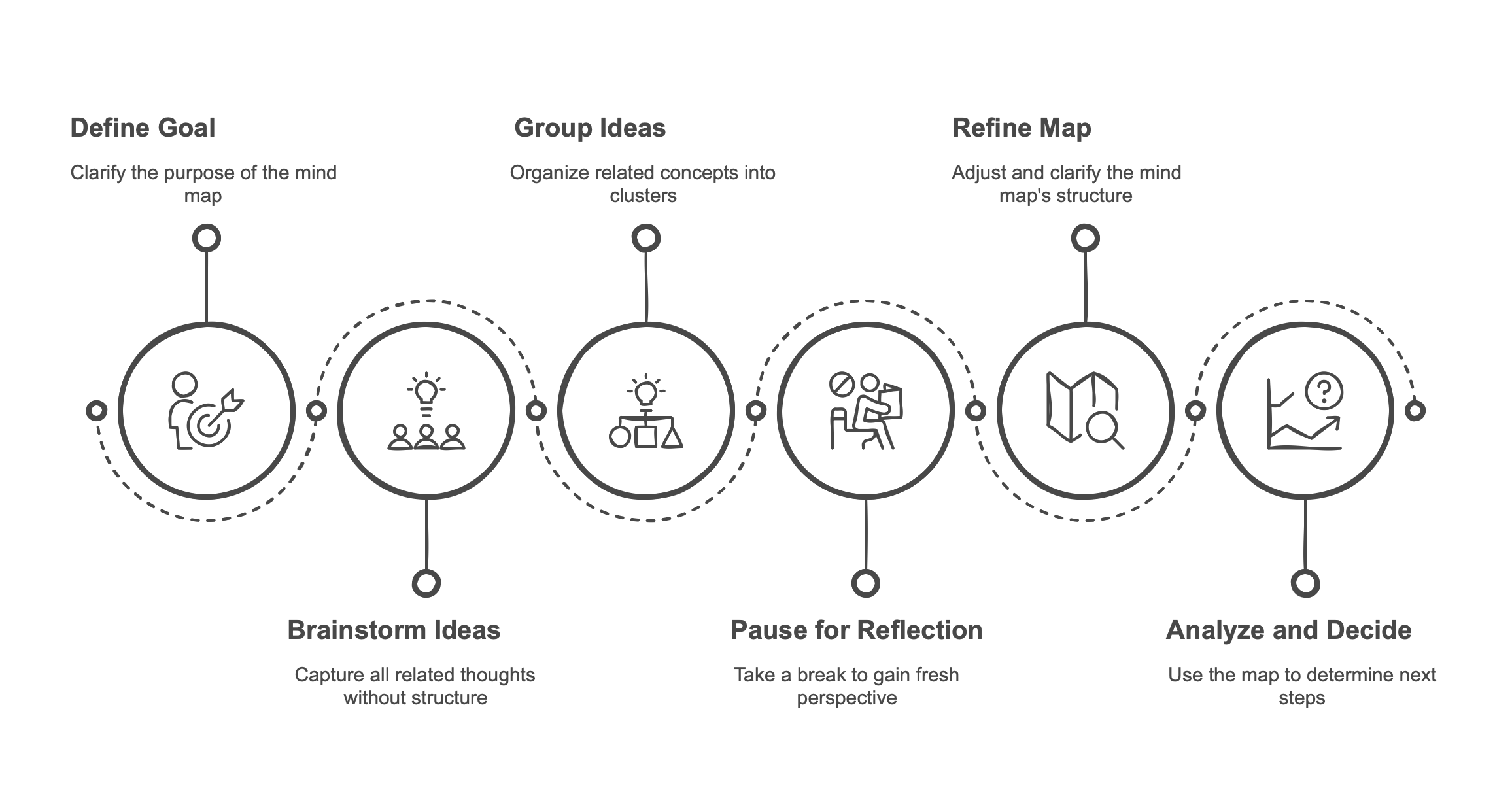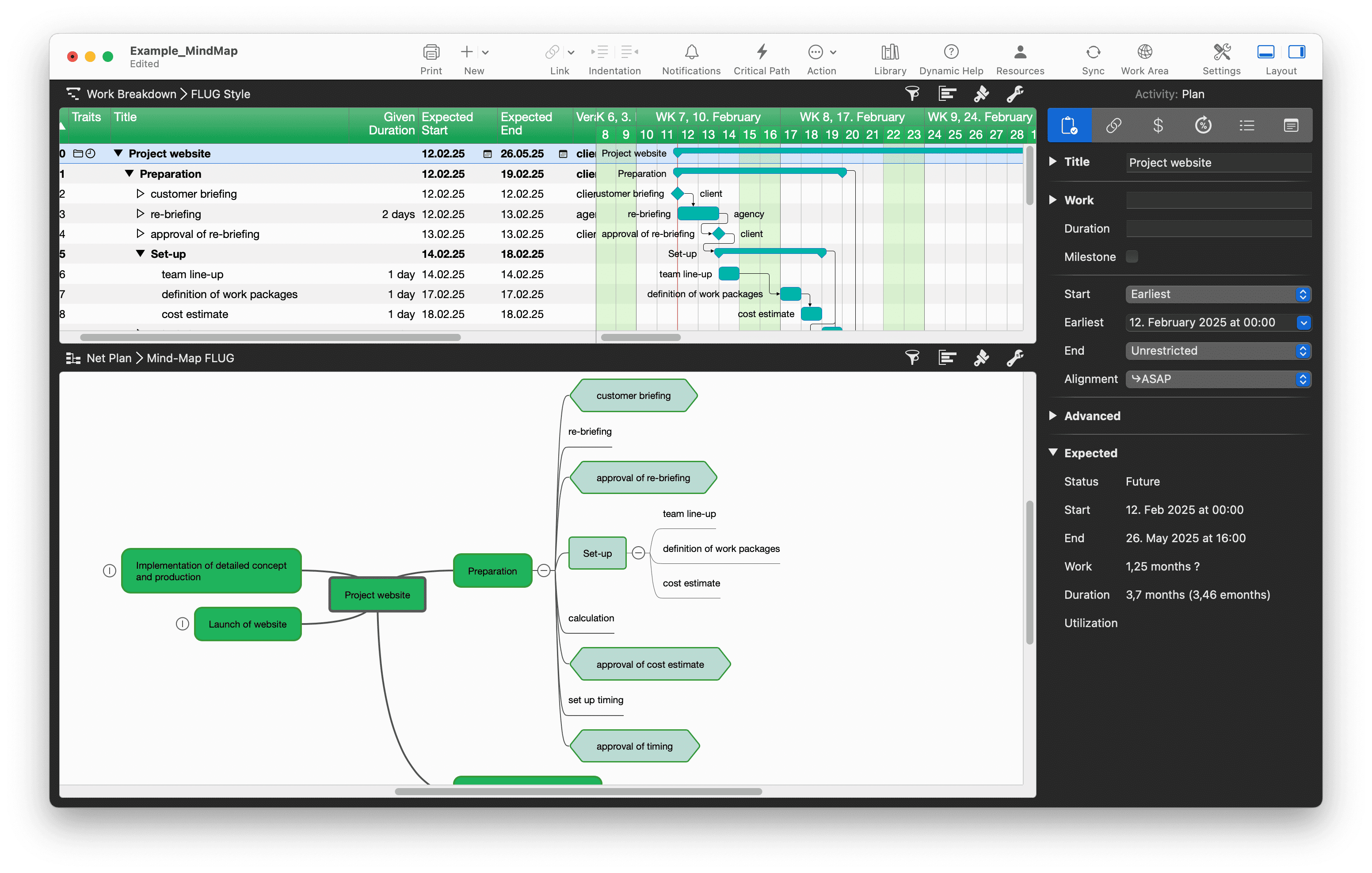Gestión de Proyectos con un Toque de Magia
Planifica, gestiona y entrega proyectos de forma eficiente. Merlin Project para macOS y iOS

Los mapas mentales te permiten organizar visualmente los pensamientos, resolver problemas y potenciar la creatividad. En esta guía, explorarás la ciencia que hay detrás de los mapas mentales, técnicas paso a paso para crear los tuyos propios y consejos de expertos para perfeccionar tu enfoque. ¿Listo para trazar tu próxima gran idea? ¡Empecemos!
Índice
Introducción a los mapas mentales
La ciencia detrás de los mapas mentales
Cómo crear un mapa mental: guía paso a paso
Consejos y trucos
Casos de uso de mapas mentales
El kit de herramientas adecuado para los mapas mentales
Gestión creativa de proyectos con Merlin Project
Reflexiones finales
Preguntas frecuentes
Los mapas mentales son algo más que garabatos en un papel. Te ayudan a organizar tus pensamientos, estructurar la información y diseccionar los problemas visualmente. Ya sea para una lluvia de ideas, para planificar un proyecto o para aprender nuevos conceptos, los mapas mentales activan tanto la lógica como la creatividad, lo que mejora la comprensión, la memoria y la colaboración.
Los mapas mentales ofrecen beneficios tangibles a cualquiera que busque claridad y estructura. Por ejemplo, un estudio de 2020 ha revelado que la «comunicación visual» puede mejorar la memorización. Durante el estudio, los resultados de las pruebas de los participantes mejoraron en un ~30 % debido a la comunicación visual.
Un mapa mental es como un atajo para tu cerebro. Permite un acceso más rápido a las ideas, conexiones más sencillas y menos obstáculos mentales. Además, los mapas mentales te liberan para explorar ángulos creativos que podrían pasarse por alto en la toma de notas lineal. Si buscas maximizar la creatividad y mejorar las habilidades para resolver problemas, los mapas mentales son una estrategia que merece la pena.

Un mapa mental es una representación visual de información que comienza con un tema central y se ramifica en temas relacionados. Refleja la forma en que tu cerebro forma conexiones de forma natural, utilizando colores, palabras clave e imágenes para generar nuevas ideas.
Tony Buzan, un autor y consultor educativo inglés, popularizó los mapas mentales en la década de 1970. Creía que la toma de notas tradicional era restrictiva y no aprovechaba todo el potencial creativo del cerebro. Cuenta la leyenda que, mientras Tony estaba repasando para los exámenes, se dio cuenta de que resaltar palabras clave y utilizar imágenes coloridas le ayudaba a recordar conceptos de forma más eficaz. A medida que enseñaba estas técnicas a otros, acuñó el término «mapa mental» para capturar la esencia del pensamiento ramificado y radiante. Con el tiempo, perfeccionó este enfoque, combinando el arte, la psicología y el entrenamiento de la memoria para crear un método accesible para cualquiera. Más información sobre las ideas de Tony Buzan.

El cerebro humano no procesa la información de forma lineal. Se nutre de relaciones, patrones y conexiones.
Tony Buzan
Los mapas mentales no son magia, sino ciencia. Aprovechan la forma en que nuestros cerebros están conectados para procesar y almacenar información. Al fusionar señales visuales con estructuras lógicas, los mapas mentales activan múltiples vías mentales, aumentando tanto la comprensión como el recuerdo.
Una estadística muy citada afirma que el cerebro humano procesa las imágenes 60 000 veces más rápido que el texto. Sin embargo, desde su primera mención en 1997, ninguna prueba científica ha respaldado esta afirmación. De hecho, hay incluso una recompensa de 60 dólares para quien encuentre la fuente original. Independientemente de esta cifra cuestionable, una cosa sigue siendo cierta: los datos visuales nos ayudan a recordar mejor la información.
Psicólogos como el Dr. John Medina enfatizan que nuestros centros de memoria, incluidos el hipocampo y la corteza frontal, forman conexiones neuronales más fuertes cuando se exponen a estímulos visuales coloridos y distintos. Esta participación visual prepara el escenario para una comprensión más profunda y una memoria más sólida. En esencia, cuantos más sentidos involucres y más único sea el estímulo (color, forma, imágenes), más «anzuelos» crea tu cerebro para recuperar esa información más adelante. (Efecto de superioridad de la imagen)
Al comprender cómo se forma la memoria en estas regiones del cerebro, puede potenciar estratégicamente tanto la retención como la comprensión. Técnicas como la agrupación (agrupar ideas relacionadas) o el uso de imágenes asociativas construyen un paisaje mental por el que es más fácil navegar. Como verá en la siguiente sección, los mapas mentales aprovechan a la perfección la visualización para amplificar los resultados del aprendizaje.
La eficacia del mapa mental se basa en principios psicológicos y cognitivos fundamentales:
Técnicas de asociación (la vinculación de conceptos crea conexiones significativas)
Cuando trazas una línea entre dos ideas, forjas un vínculo mental. Cada nodo y rama refleja cómo los conceptos se superponen o divergen. Por ejemplo, conectar una rama de «marketing» a una rama de «comportamiento del cliente» facilita la visualización de perspectivas interfuncionales. Este proceso de vinculación constante ayuda a tu mente a almacenar y recuperar información de una manera más dinámica que la toma de notas aisladas.
Memoria a través de la visualización (los diseños coloridos y las imágenes mejoran el recuerdo)
Imagina una rama de color rojo brillante con la etiqueta «Tareas urgentes» y una rama azul con la etiqueta «Objetivos a largo plazo». Tu cerebro clasifica inmediatamente estas ideas en función del color, formando una estructura visualmente memorable. Los psicólogos llevan mucho tiempo observando que la codificación dual, que combina elementos visuales con texto, consolida los recuerdos de forma más eficaz que el texto solo.
Creatividad (la lluvia de ideas no estructurada promueve el pensamiento innovador)
Dado que los mapas mentales no te obligan a seguir un camino rígido y lineal, eres libre de dar saltos a asociaciones inesperadas. En lugar de seguir una secuencia prescrita, exploras vías paralelas de pensamiento. Esta libertad a menudo da lugar a conceptos innovadores que nunca podrían surgir en una simple lista o esquema.
Colaboración (los mapas mentales compartidos fomentan el trabajo en equipo y la alineación)
A nivel de equipo, las sesiones de lluvia de ideas visuales rompen las barreras de comunicación. Un mapa mental compartido ayuda a cada miembro a ver cómo encajan sus ideas en el panorama general. Al centralizar las notas y los bocetos en un solo lugar, el equipo puede alinearse en cuanto a objetivos, responsabilidades y plazos, haciendo que el trabajo en grupo sea más coherente y colaborativo.

Dime y lo olvido, enséñame y puedo recordar, involúcrame y aprendo.
Benjamin Franklin
Siga estos pasos prácticos para empezar a plasmar sus ideas de forma eficaz:

Defina su objetivo:
Empiece por aclarar por qué está creando el mapa mental. ¿Está planificando un proyecto, resolviendo un problema o estudiando una nueva materia? Identificar claramente su objetivo le ayudará a mantener la concentración. Establezca un resultado tangible para la sesión, como generar una lista de los próximos pasos u organizar un conjunto específico de datos. Con un objetivo bien definido, estará mejor preparado para filtrar la información irrelevante y mantener su mapa optimizado.
Empiece la lluvia de ideas:
Anote todas las ideas que le vengan a la mente relacionadas con su tema central. No se preocupe todavía por la estructura o la jerarquía. Capture todos los pensamientos, palabras, imágenes o frases que surjan. Si está trabajando en grupo, utilice notas adhesivas o una herramienta digital para que todos puedan contribuir simultáneamente. Aproveche esta etapa de flujo libre para desbloquear el pensamiento creativo sin restricciones.
Agrupar ideas:
Una vez que tenga un conjunto de ideas, comience a agrupar conceptos relacionados. Si ciertos temas van naturalmente juntos, como «presupuesto», «recursos» y «cronograma», colóquelos en la misma rama. Esta agrupación revela patrones o temas emergentes. Piense en ello como organizar un escritorio desordenado: agrupar elementos similares no solo ordena el espacio, sino que también le ayuda a localizar lo que necesita más rápidamente.
Hacer una pausa para reflexionar:
Aléjate de tu mapa mental para hacer una breve pausa. Una mirada fresca a menudo detecta lagunas o inconsistencias. Al volver más tarde, es posible que notes que un grupo podría tener subramas, o que otra rama es superflua. Esta pausa garantiza que no te conformes con una estructura a medias.
Perfecciona y revisa:
Después de la pausa, perfecciona tu mapa mental añadiendo o eliminando ramas, aclarando etiquetas y reorganizando conexiones. Busca la claridad: elimina duplicados, corrige errores tipográficos y ajusta el diseño visual para que sea agradable a la vista. Este paso transforma tu lluvia de ideas inicial en un mapa visual estructurado que comunica su propósito y contenido.
Analizar y decidir:
Por último, utilice el mapa mental para tomar decisiones o dar los siguientes pasos. Identifique patrones, priorice tareas o planifique sus acciones de seguimiento. Un mapa mental es tan útil como las ideas que genera. Traduzca esas ideas en pasos que pueda llevar a cabo de inmediato. En este punto, dispondrá de una poderosa herramienta para guiar la estrategia, resolver problemas o mantener a su equipo alineado.
Piense en su mapa mental como un árbol. El tema central es el tronco, mientras que las ramas y subramas son sus ideas principales y detalles de apoyo. Comience con categorías amplias y vaya acotando su enfoque a medida que se ramifica. Este enfoque jerárquico ayuda a mantener la claridad y garantiza que no se pierdan puntos clave.
Los colores hacen que su mapa sea atractivo y ayudan a separar las ideas. Asigne un color específico para cada rama principal y apéguese a él. Además, utilice colores para establecer prioridades, por ejemplo, rojo para las tareas urgentes, etc. Del mismo modo, cree una jerarquía visual: las ideas principales en fuentes más grandes y llamativas; las subideas en un tipo de letra más pequeño. Un formato y una combinación de colores coherentes aceleran la comprensión y reducen el desorden visual.
Utilice la vista de mapa mental como una forma alternativa de mostrar el plan del proyecto. El mapa mental es solo otro tipo de vista del archivo Merlin Project. La sección de detalles también le permite ver y editar dos tipos de vista en paralelo. Esto es útil cuando se trata de afinar el proyecto.

Cuando se inicia un nuevo tipo de proyecto que no es algo habitual, a menudo se recopilan paquetes de trabajo en el equipo durante la puesta en marcha y luego se van elaborando gradualmente en detalle. Me gusta utilizar la vista de mapa mental en la puesta en marcha, donde capturo todos los paquetes de trabajo, hitos e incluso los primeros pasos detallados. Con un solo clic, puedo cambiar a la vista de división del trabajo y tener una base fantástica para mi plan de proyecto. La configuración es rápida y fácil, como por arte de magia.
Kathrin Lamm, Formador certificado de Merlin Project

Las palabras clave cortas y contundentes triunfan sobre las frases largas en un mapa mental. Son más rápidas de leer y más fáciles de recordar. Mantenga una estructura paralela (por ejemplo, «Planificar», «Ejecutar», «Revisar») para garantizar un flujo coherente. Los iconos también pueden mejorar el reconocimiento. Utilice símbolos sencillos (como un calendario para las fechas límite o una bombilla para las ideas creativas) para dar un contexto inmediato.
Si encuentra que ciertos nodos son ricos en datos (como números de presupuesto, referencias o adjuntos), considere la posibilidad de estratificar esa información detrás de hipervínculos o notas emergentes si su herramienta lo permite. De esta manera, mantiene limpia la vista principal y, al mismo tiempo, tiene acceso rápido a más detalles.
Cuando varias personas contribuyen a un mapa mental, puede surgir confusión si los cambios se producen simultáneamente. Utilice una herramienta digital con control de versiones o funciones de edición en tiempo real. Esto le garantiza el seguimiento de las modificaciones, evita sobrescribir el trabajo de los demás y siempre tiene una copia de seguridad de las versiones anteriores si necesita revertir los cambios.
Los mapas mentales son excelentes para fomentar nuevas ideas. Al visualizar los pensamientos en un formato no lineal, se crea un espacio mental para que florezca la creatividad. Las técnicas comunes de lluvia de ideas que combinan bien con los mapas mentales incluyen:
Los mapas mentales descomponen los problemas complejos en partes digeribles, lo que facilita abordar las causas fundamentales y proponer soluciones. Un marco eficaz es el principio MECE: mutuamente excluyente, colectivamente exhaustivo. Popular en la consultoría de gestión, el MECE garantiza que cada categoría sea distinta (sin solapamientos) y que cubra colectivamente todas las posibilidades (sin lagunas).

Identifique el problema principal
Coloque el tema o la pregunta principal en el centro (por ejemplo, «Mejorar la satisfacción del cliente»).
Cree ramas MECE de nivel superior
Desglose en categorías principales asegurándose de que se excluyan mutuamente, como «Problemas relacionados con el producto», «Problemas relacionados con el servicio» y «Problemas relacionados con los precios». Estas categorías no deben superponerse. Además, estas categorías deben ser colectivamente exhaustivas, ya que capturan la declaración del problema desde todos los ángulos posibles.
Expanda cada rama exhaustivamente
En cada rama, enumere los subfactores para que, en conjunto, aborden todos los ángulos. Para «Problemas relacionados con el servicio», puede tener «Comunicación», «Tiempo de respuesta» y «Calidad de la asistencia» como subramas.
Analizar y priorizar
Una vez que el árbol esté completo, analice qué categorías o subramas tienen el mayor impacto. Un resaltado visual o una clasificación codificada por colores pueden ayudarle a ver qué áreas necesitan una acción inmediata.
Formule medidas de acción
Por último, convierta cada subrama en una lista clara de tareas pendientes o en una ruta de solución. Dado que la estructura es intrínsecamente lógica y completa, tendrá una estrategia sólida y sin lagunas.
Los mapas mentales se pueden hacer con papel y lápiz o con herramientas digitales. El papel ofrece la libertad de dibujar en cualquier lugar y en cualquier momento, perfecto para notas personales rápidas o garabatos creativos. Pero es menos conveniente para proyectos grandes, colaboración o actualizaciones frecuentes. El software digital, por otro lado, ofrece potentes funciones como edición en tiempo real, fácil reorganización e integración multimedia, ideal para el trabajo dinámico en equipo.
Al elegir una herramienta digital, busque funciones que mejoren su proceso creativo y satisfagan necesidades prácticas, desde la lluvia de ideas con IA hasta la exportación de informes profesionales:
Las aplicaciones modernas de mapas mentales, como Merlin Project, aprovechan la inteligencia artificial (IA) para apoyar la lluvia de ideas. La IA puede agrupar ideas similares automáticamente, sugerir conexiones potenciales que podrías pasar por alto e incluso generar mapas mentales iniciales basados en una pregunta. Esto cambia las reglas del juego si estás abordando un tema amplio y necesitas un impulso adicional para poner en marcha la creatividad u organizar una montaña de ideas.
En el entorno de trabajo conectado de hoy, la colaboración es esencial. Elige un software con sincronización automática para que todos los miembros del equipo puedan trabajar desde cualquier lugar. Las funciones de colaboración en tiempo real garantizan que los cambios sean visibles al instante, permiten la comunicación directa dentro de la herramienta y aseguran que todos trabajen con la misma información actualizada.
A veces necesitas más que un simple mapa mental; necesitas una presentación bien elaborada para partes interesadas o clientes. Las herramientas con funciones de informes — filtrado, vistas jerárquicas y múltiples opciones de exportación — te ayudan a adaptar la vista final para tu audiencia.
Mapas mentales para la ideación
Merlin Project eleva la lluvia de ideas al integrar a la perfección mapas mentales intuitivos con una sólida planificación de proyectos. Empiece por capturar y organizar sus ideas en un mapa mental de flujo libre, donde podrá añadir rápidamente nodos, ramificar conceptos y estructurar visualmente los temas centrales de su proyecto, todo ello en una única interfaz fácil de usar.
De la creatividad a la planificación detallada
Cuando esté listo para pasar de la ideación creativa a la planificación detallada, Merlin Project le permite convertir su mapa mental en una estructura completa de división del trabajo. Esta transformación organiza automáticamente sus ideas en tareas estructuradas, completas con fechas de inicio y finalización, dependencias y asignaciones de recursos. Tanto si prefiere los diagramas de Gantt tradicionales como los tableros Kanban ágiles, todas las vistas permanecen sincronizadas para que los datos de su proyecto estén siempre actualizados.
Vistas unificadas y colaboración en tiempo real
Al unificar el proceso creativo con una gestión de proyectos rigurosa, Merlin Project ofrece la flexibilidad de iterar sus ideas mientras mantiene una única fuente de verdad en todas las vistas de planificación. Esta sincronización en tiempo real mejora la colaboración en equipo, le permite adaptarse rápidamente a los cambios y, en última instancia, agiliza su flujo de trabajo desde la lluvia de ideas inicial hasta la ejecución final.

Además, puede ser muy creativo con nuestros mapas mentales. Aquí tiene dos ejemplos:
Los mapas mentales son una revolución para cualquiera que busque un enfoque estructurado pero creativo para abordar problemas, organizar información o colaborar eficazmente. Tanto si prefiere la sensación táctil del lápiz sobre el papel como las amplias capacidades de las herramientas digitales como Merlin Project, los principios básicos siguen siendo los mismos: visualizar, conectar y perfeccionar.

Si puedes visualizarlo, si puedes soñarlo, hay alguna forma de hacerlo.
Walt Disney
¿Listo para dar el primer paso? Sumérgete en los recursos vinculados a lo largo de esta guía o abre un lienzo en blanco y empieza a trazar tu próxima gran idea. ¡Tu cerebro, y tus proyectos, te lo agradecerán!
Sus ideas, nuestra magia – ¡realice proyectos de forma sencilla!
Pruebe ahora 30 días de forma gratuita.
